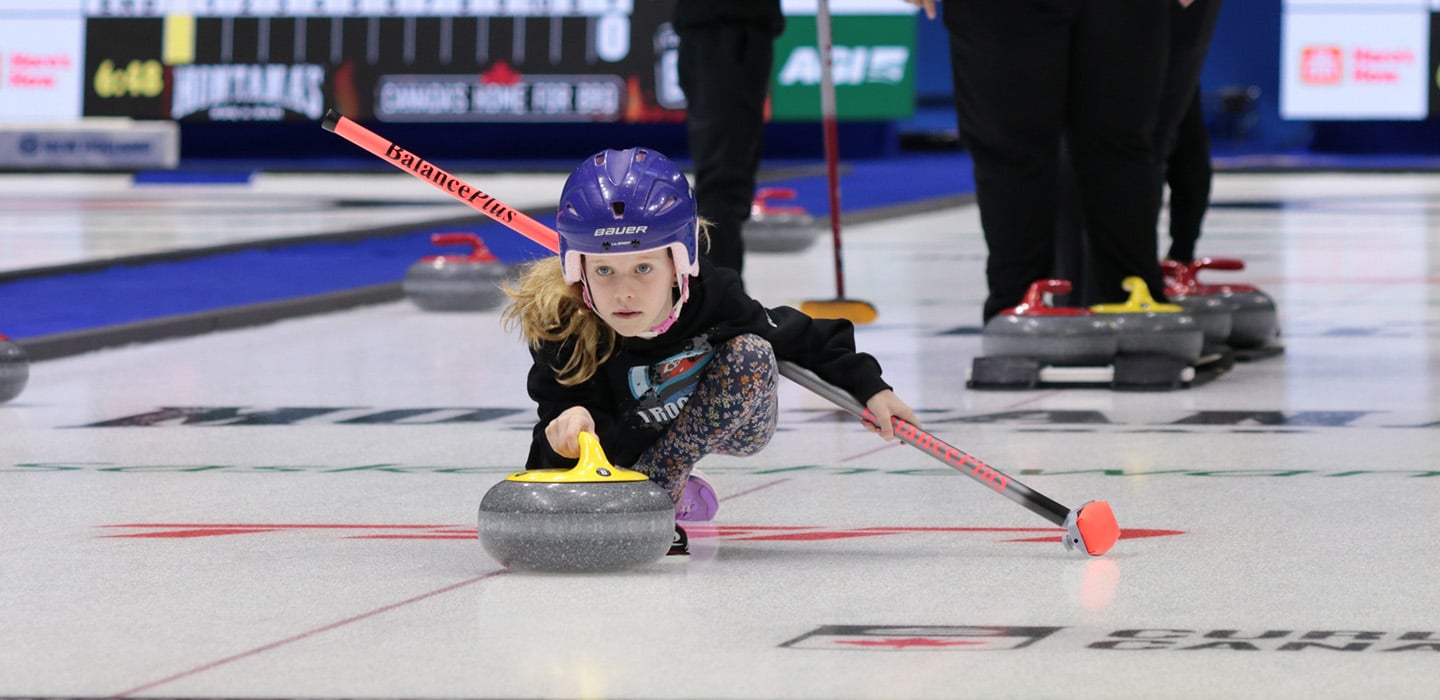Staying safe on the ice!

Should you add protective headgear to your curling kit this year? A guide to safety recommendations (and style)
By: Sheri Block
A professional pair of curling shoes, a colourful new carbon fibre broom and a protective helmet?
Headgear may not be on the list for all recreational curlers returning to the hack this fall, but it is something players might want to consider – especially those who are new to the sport, kids or seniors, according to Jennifer Ferris, Curling Canada’s Sport Safety and Education Officer.
“We have very little data on injuries within curling itself, but we do know that every year there are some severe injuries, some even leading to fatalities, and for the most part, the injuries tend to happen with people who are older or people who are very new to the sport,” says Ferris.
She says using a helmet won’t always prevent a concussion, but it can help prevent severe skull fractures or a brain bleed.
Even with the seriousness of a potential injury, Curling Canada, as a National Sports Organization (NSO), can’t mandate helmet use as each club operates independently.
They do have a list of recommendations on their website that includes helmets being mandatory for anyone under the age of 12 and strongly recommended for anyone in a Learn-To-Curl program or at a Try to Curling Event. They also have a full concussion policy.
Ferris says she sees helmet wear becoming more normalized at the recreational level– especially among stick curlers, youth and seniors.

Candace Konnert, a recreational curler from Calgary, is now wearing a helmet after she lost her balance sweeping and fell on the ice last season. Luckily, she didn’t hit her head, but she did strain some ligaments in her neck. The experience prompted her to now wear a helmet every time she’s on the ice.
“It just happened so quickly. I didn’t think anything of it. I thought, ‘Oh, it’s just a fall,’ and I’d seen lots of people fall. But it did change my view of wearing protective headgear,” says Konnert.
“I know how serious concussions can be and I know how quickly they happen.”
Her husband also took a fall last season sliding out of the hack. He hit his head, developed a laceration and went to the ER. He recovered without any serious side effects and now wears a helmet.
As well as wearing a helmet or other protective headgear, Ferris says curlers can protect themselves by wearing proper curling shoes (or running shoes with pliable rubber soles) and making sure their grippers are in good condition, as even the most seasoned curlers can fall if the edges are worn.
New helmet recommendations for young curlers
This fall, a new set of helmet recommendations and concussion guidelines for Youth Curling at Curling Canada events will be rolled out. Head protection will be mandatory for all participants aged 11 and under and strongly recommended for those aged 12 and over, especially if they are new to the sport or not yet proficient on the ice.
There currently isn’t a CSA-approved helmet specifically for curling, but acceptable head protection includes approved helmets for use on ice and/or snow (such as hockey or snowboarding) or for skateboarding and/or equestrian activities. Bike helmets are also acceptable (marking a change from the previous guidelines), as is headgear with built-in impact plates such as toques or ballcaps if used with chinstraps.
Concussion symptoms and guidelines must also be reviewed every year.
Stylish and safe: How to choose protective headgear
While a helmet made for ice provides fuller protection, there are a range of options for curlers who want something a bit more low-profile and stylish.

Goldline offers a colourful array of toques, po’boy hats, headbands (including one in hot pink) and baseball caps, all fitted with an expanded polystyrene (EPS) plate to protect the back of the head in the event of a fall.
“(We heard) the No.1 reason that kept people from using a helmet was they don’t want to look like they were wearing a helmet and that’s when we went into the headband, toque and ballcap,” says Erin Flowers, president of Goldline Curling.
She says the products have been extremely popular.
“We have great response to the more stylish products. We also sell a lot of helmets because some people want ultimate protection,” says Flowers.
Dynasty Curling also offers a line of protective headwear, including toques and headbands that feature a pliable material with molecules that tightly lock together upon impact to disperse and absorb impact. The toques come in an array of colours, including black, pink, royal blue and camo.
Hardline and Asham also offer helmet options.
While wearing any form of protective headwear is better than no protection, Ferris advises curlers who choose one of the non-helmet options to make sure they wear the accompanying chinstrap.
“They’re only good if they stay on your head so using a chinstrap is really important because you never know if you bump into another sweeper or throw your hands up as you’re falling you can quite easily throw a ballcap or toque off,” says Ferris.
While halo/headband styles won’t be able to be used at Curling Canada’s Youth Events – they may still be an option for adult club curlers as long as the curlers understand the risk that halo/headband style headgear may slip off in the event of a collision. Any type of head protection is better than no protection and many stylish/athletic options are available.
Curling Canada will continue to analyze injury data over the coming years and amend recommendations if required.




